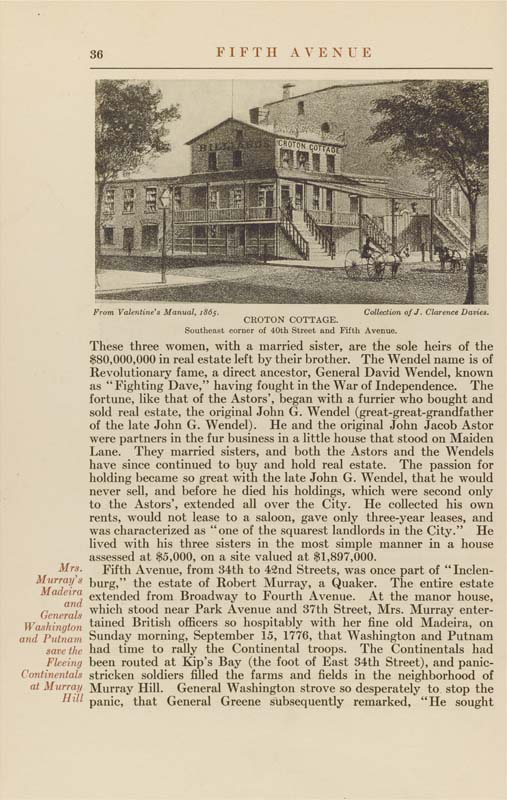36
FIFTH AVENUE
Mrs.
Murray's
Madeira
and
Generals
Washington
and Putnam
save the
Fleeing
Continentals
at Murray
Hill
From Valentine's Manual, 1865. Collection of J. Clarence Davies.
CROTON COTTAGE.
Southeast corner of 40th Street and Fifth Avenue.
These three women, with a married sister, are the sole heirs of the
$80,000,000 in real estate left by their brother. The Wendel name is of
Revolutionary fame, a direct ancestor. General David Wendel, known
as "Fighting Dave," having fought in the War of Independence. The
fortune, like that of the Astors', began with a furrier who bought and
sold real estate, the original John G. Wendel (great-great-grandfather
of the late John G. Wendel). He and the original John Jacob Astor
were partners in the fur business in a little house that stood on Maiden
Lane. They married sisters, and both the Astors and the Wendels
have since continued to buy and hold real estate. The passion for
holding became so great with the late John G. Wendel, that he would
never sell, and before he died his holdings, which were second only
to the Astors', extended all over the City. He collected his own
rents, would not lease to a saloon, gave only three-year leases, and
was characterized as "one of the squarest landlords in the City." He
lived with his three sisters in the most simple manner in a house
assessed at $5,000, on a site valued at $1,897,000.
Fifth Avenue, from 34th to 42nd Streets, was once part of "Inclen¬
burg," the estate of Robert Murray, a Quaker. The entire estate
extended from Broadway to Fourth Avenue. At the manor house,
which stood near Park Avenue and 37th Street, Mrs. Murray enter¬
tained British officers so hospitably with her fine old Madeira, on
Sunday morning, September 15, 1776, that Washington and Putnam
had time to rally the Continental troops. The Continentals had
been routed at Kip's Bay (the foot of East 34th Street), and panic-
stricken soldiers filled the farms and fields in the neighborhood of
Murray Hill. General Washington strove so desperately to stop the
panic, that General Greene subsequently remarked, "He sought
|








